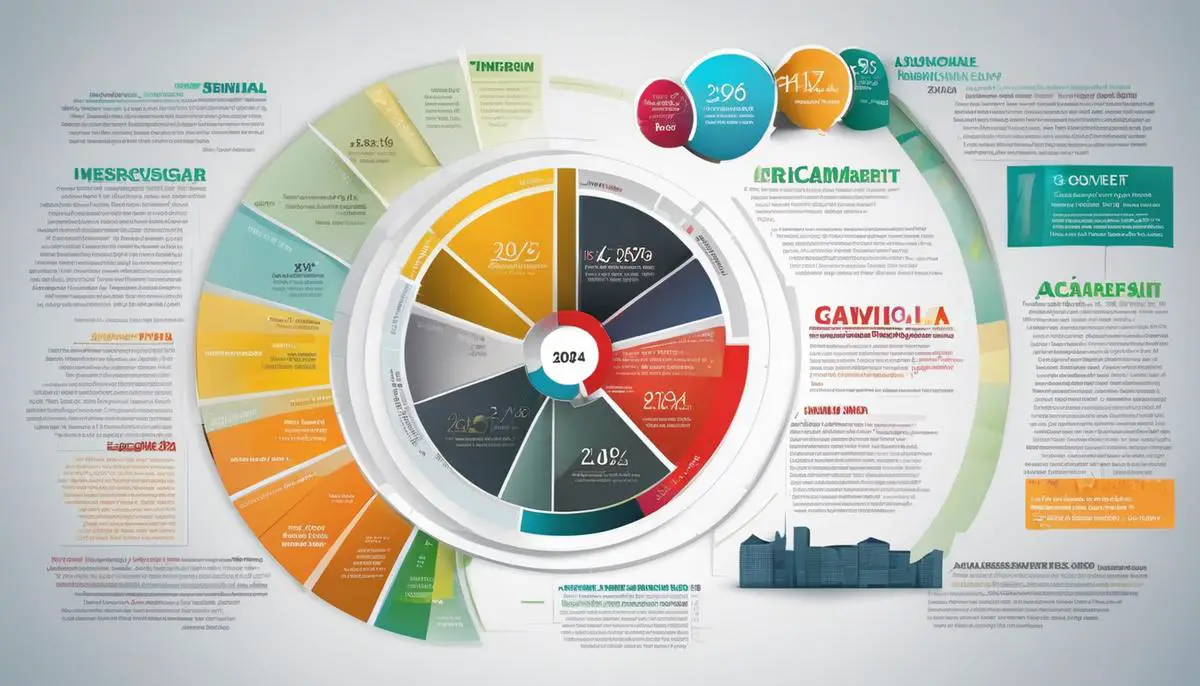2024 Annuity Trends for Retirement Planning
As society embarks on the cusp of 2024, the landscape of retirement planning brims with change, particularly in the realm of annuities. In an epoch characterized by innovation and adaptation, annuity products have begun to reflect a more complex financial ecosystem. With advancements tailored to yield better returns and accommodate diverse investor needs, understanding these shifts becomes essential for those crafting their retirement futures. This essay delves into the multifaceted world of annuities, exploring their evolution in design and utility, the influence of fluctuating regulations, and the technological undercurrents that are reshaping how retirees approach and manage these financial instruments. As macroeconomic forces ebb and flow, the annuity marketplace adjusts, mandating a discerning analysis for anyone vested in sculpting a reliable pillar of their retirement strategy.
Evolving Annuity Products
Adapting Annuities: Navigating the Shifting Financial Terrain of 2024
As we find ourselves immersed in an ever-evolving financial ecosystem, the dynamics underpinning retirement planning and income continuation are being recalibrated. In particular, annuity products—a cornerstone in the financial planning process for many—have undergone noteworthy adaptations responding to the changing financial landscape anticipated for 2024. These adaptations are not frivolous; rather, they are a thoughtful response to market volatility, interest rate fluctuations, and a population increasingly concerned with financial security in their post-career years.
Traditionally, annuities have provided individuals with a reliable stream of income, typically during retirement, through a contract with an insurance company. The user pays a sum (either lump-sum or through periodic payments), and in return, the insurance company promises to make payments back to the individual either immediately or at a future date. It’s a product defined by its ability to mitigate risk—specifically, the risk of outliving one’s savings.
Despite their solidity in principle, annuities must adapt to remain relevant and valuable. In 2024, this entails a multifaceted approach that addresses interest rate sensitivity, longevity risk, and consumer demand for flexibility and transparency.
The current interest rate environment continues to challenge traditional fixed annuities, which offer a guaranteed return. Annuity providers are innovating to ensure these products can still fulfill their promise despite unpredictable rate movements. One manifestation of this adaptation is the broader use of indexed annuities tied to a financial index performance. These instruments allow policyholders to benefit from market upswings while maintaining a level of protection against downturns.
Furthermore, annuities are being crafted to provide greater liquidity options. Annuity holders, especially the younger cohort entering retirement planning, show increasing concern over lock-up periods. Products offering structured withdrawal schemes without heavy penalties are seeing a surge as providers seek to balance flexibility with fiscal responsibility.
In direct response to a clientele living longer, healthier lives, and thus requiring a longer period of income supplementation, annuity providers are investing in products that deal more directly with longevity risk. Longevity annuities—or deferred income annuities—are gaining traction. These products delay payout until later in life, thereby securing higher annual payouts and covering the risk of outliving other income sources.
Last but not least, a push for transparency has been pivotal. Consumers now, more than ever, demand clarity in terms of fees, terms, and conditions. The response has been the development of simpler products with straightforward fee structures and terms that can be easily understood by the average investor without extensive financial expertise.
Annuity providers are thus steering through a complex array of challenges: they are tasked with creating products that are responsive to a shifting economy and changing demographic trends while maintaining a keen eye on regulatory developments and consumer expectations. It is a delicate balancing act that requires foresight, innovation, and a commitment to the annuity’s longstanding promise: financial stability and predictability in an unpredictable world.

Regulatory Influence on Annuities
Regulatory alterations in the financial sector invariably have profound repercussions on the fabric of investment instruments, and the annuity market in 2024 is no exception. Refined regulations have been instituted with the intent to fortify consumer protections while promoting fair market practices.
One conspicuous impact of these changes on annuities is the tightening of solvency standards. Annuity providers must now bolster their financial underpinnings to assure that commitments to policyholders are unassailable. Enhanced capital requirements ensure that companies are better equipped to weather economic downturns and honor payments to retirees. This fosters an environment of reliability, critical for the retirement planning sector.
The enforcement of meticulous sales practices and advisor fiduciary duties stands at the forefront of recent regulatory updates. In response to these demands, the annuity market is poised to see a shift towards more scrupulous sales techniques, where advisors must judiciously recommend products that align with a client’s best interests. The potential upshot is a surge in consumer trust, a currency as valuable as the financial assets under advisement.
Furthermore, regulatory changes are stimulating innovation within product offerings. New annuities emerging in 2024 are projected to integrate features prioritizing flexibility and policyholder control. These regulatory-driven products likely embody customizable riders and benefits, enabling consumers to tailor their annuity contracts to address individual retirement objectives more precisely.
Regulatory bodies are also reaffirming their commitment to the explication of complex financial instruments such as annuities. Hence, one can anticipate an upsurge in the accessibility of educational resources, with annuity providers proactively disseminating comprehensive guides and toolkits to clarify the nuances of annuity products. Such educational endeavors aim to empower consumers to make more informed decisions, thus reducing incidences of mis-sold annuities.
Lastly, regulation compels an increased level of harmonization in the reporting standards across annuity products. Uniform disclosure mandates stipulate that all annuity offerings must transparently reveal costs and benefits in a consistent manner. As a result, this allows for straightforward comparisons between products, potentially heightening competitive pressures and driving innovation as annuity providers vie to distinguish their offerings.
The regulatory landscape for annuities in 2024 is calibrated to bridge the gap between complex financial products and the broader aim of safeguarding retiree income. While each change brings a fresh set of challenges and opportunities, one thing is certain: the annuity market is set to evolve in ways that accentuate security, transparency, and adaptability to the benefit of all stakeholders.

Consumer Trends in Annuity Selection
Understanding Consumer Preferences: Strategic Responses in Annuity Offerings for the Retirement Market of 2024
Annuities stand at the crossroads of retirement security, offering a reprieve from the uncertainties that plague retirees in their golden years. These financial instruments have undergone a substantial evolution to resonate with the contemporary consumer psyche, which craves not only stability but also the flexibility to adapt to an ever-changing macroeconomic milieu.
In the landscape of 2024, demand for diverse annuity products is being shaped by burgeoning consumer trends molded by socio-economic transitions. Individuals approaching retirement are exhibiting a pronounced predilection for products that align with their personal values, including sustainable investment options. The ‘greening’ of annuities, wherein underlying investments prioritize environmentally conscious companies, is answering this clarion call, rendering a new dimension of ethical investment choices.
Further, the digital era has begotten consumers who are acutely conversant with technological interfaces. This tech-savviness is informing their desire for digital tools and platforms that allow for the management of their retirement portfolios with a few clicks or swipes. Providers are responding by augmenting their technological infrastructure to enable self-service capabilities and real-time account monitoring, engendering an empowered class of retirees who can navigate their financial futures with greater autonomy.
Equally consequential in annuity selection is the detour from one-size-fits-all products. Personalization has become paramount, and annuity solutions are increasingly being tailored to the individual’s financial persona. This level of customization allows retirees to calibrate their income streams vis-à-vis discretionary spending and unforeseen healthcare costs, which perennially pose as wildcard expenditures during retirement.
Moreover, amidst the shifting sands of social norms, the definition of retirement is being rewritten. With more individuals opting for phased retirement or part-time engagements post-retirement, the need for annuity products that complement partial income without incurring punitive consequences for early withdrawal or employment is significantly influencing product adjustments.
Lastly, the social construct of the family unit continues to evolve, and annuity products are being designed to reflect this. There is a growing demand for options that provide for not only the annuitant but also for extended family members or dependents, thereby endowing annuity selections with a broader protective ambit.
As providers strive to forecast and accommodate these emergent trends, it is incontrovertible that the annuity landscape of 2024 will be characterized by innovative convergence of consumer preferences and product strategy—each influencing and reshaping the other in an ongoing dialogue meant to ensure financial security during the incalculable journey of retirement.

Technological Advancements in Annuity Management
Technology and the Future of Annuity Management
The transformation of annuity management through technology is particularly profound in the realm of analytics and decision-making. At the forefront of this transformation is the utilization of big data and predictive analytics. In an age where enormous volumes of data can be gathered and processed, annuity providers are harnessing this potential to better understand consumer behaviors, investment patterns, and risk profiles.
Intelligent algorithms now play a pivotal role in shaping annuity management strategies. These algorithms aid in the assessment of market conditions, predicting longevity risks with greater accuracy, and recommending optimized annuity product combinations tailored to individual client profiles. The use of machine learning techniques further refines the personalization of annuities, taking into account dynamic factors such as changing health status, income needs, and life events, thus providing a more responsive and fluid approach to retirement planning.
Advancing further, the integration of Artificial Intelligence (AI) in customer service platforms is redefining interactions between consumers and annuity providers. AI-driven chatbots and virtual assistants enable real-time, 24/7 support for annuity holders, answering queries, providing updates on account values, and even facilitating transactions. This automation not only streamlines operations but also significantly enhances customer experience by providing instant and accurate information.
Moreover, blockchain technology is emerging as a transformative force in enhancing the security and efficiency of annuity transactions. The immutable nature of blockchain ledgers ensures that all records of annuity contracts and payments are secure from tampering. Additionally, smart contracts – self-executing contracts with the terms of the agreement directly written into code – are simplifying and automating the enforcement of contract terms, thereby reducing the administrative burden and potential for disputes.
Last h5>ly, annuity management platforms are being equipped with sophisticated dashboard interfaces that offer clients a comprehensive view of their annuity holdings. These interfaces are designed for ease of use, allowing users to monitor performance, adjust contributions, and simulate future scenarios based on varying inputs. The emphasis on user-centric design ensures that technology serves to empower the consumer, making complex financial retirement products accessible and manageable for the average person.
In conclusion, the convergence of big data, AI, blockchain, and user-friendly platforms is propelling annuity management into a new era marked by precision, personalization, and enhanced user control.
The landscape of annuity management is thus being reshaped into a more agile, secure, and client-oriented ecosystem, with technology paving the way for a future where retirement planning is not only more efficient but also more attuned to the evolving needs and lifestyles of retirees.

Impact of Economic Trends on Annuities
As the intricate dance of macroeconomic factors continues, one can anticipate that the year 2024 will render a compelling landscape for the annuity market. The macroeconomic environment, a tapestry interwoven with the threads of inflation rates, government policy, demographic shifts, and global economic health, bears significant influence on the desirability of annuities as a financial instrument for securing a stable retirement income.
Inflation stands as a primary macroeconomic element that has the potential to erode the purchasing power of fixed-income investments. Annuities, which are often pegged to offer steady payouts, can seem less attractive in an environment where high inflation prevails. To render annuities more alluring amidst inflationary pressure, providers might infuse products with features such as inflation-adjusted payouts, which maintain purchasing power over time. Conversely, if inflation rates were to moderate or decline, the certainty provided by fixed annuities might see heightened appeal to those seeking stability.
The fiscal policies enacted by governments, particularly those relating to taxation of annuity products, are pivotal in shaping their allure. Should 2024 unfurl favorable tax treatments or incentives for annuity investment, one may witness a surge in adoption. On the contrary, should policies discourage long-term, tax-deferred growth, it would undoubtedly cast a shadow on the attractiveness of annuities. Close observation of legislative trends concerning retirement savings is essential for anticipating such shifts in demand.
Another critical factor is the changing demographic tapestry, notably the aging population. As the proportion of retirees to the workforce expands, so too does the potential market for annuities. This demographic shift could engender increased demand for annuity products that provide lifetime income, thus buoying their appeal.
Lastly, the global economic climate, interlaced with myriad factors including international trade dynamics, geopolitical stability, and cross-border capital flows, possesses the capacity to influence annuity attractiveness tangentially. A robust global economy instills confidence and enhances the capacity for investment growth, potentially diverting interest away from the conservativism of annuities. In contrast, uncertainties and economic turbulence on the world stage often drive investors towards the safety and guaranteed income provided by annuities.
As 2024 approaches, one will continue to scrutinize these macroeconomic factors and trends with great interest, knowing that their interplay will inevitably mold the landscape within which annuities either flourish or flounder as a cornerstone of retirement planning.

The intricate tapestry of annuity trends and economic variables presents a challenging yet informative vista for the discerning retiree or investor. As we stand at the threshold of 2024, the insights gleaned from this analysis underscore the ever-evolving nature of retirement planning. While the constancy of change is a given, the adaptability of annuity products, the evolution of technological tools, and the dynamism of the regulatory sphere equip individuals to navigate this complexity with increased sophistication. Grasping these myriad factors will be instrumental for those looking to anchor their golden years in financial security amidst the turbulent seas of the global economy.



Leave a Reply